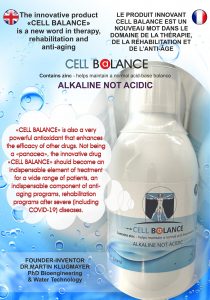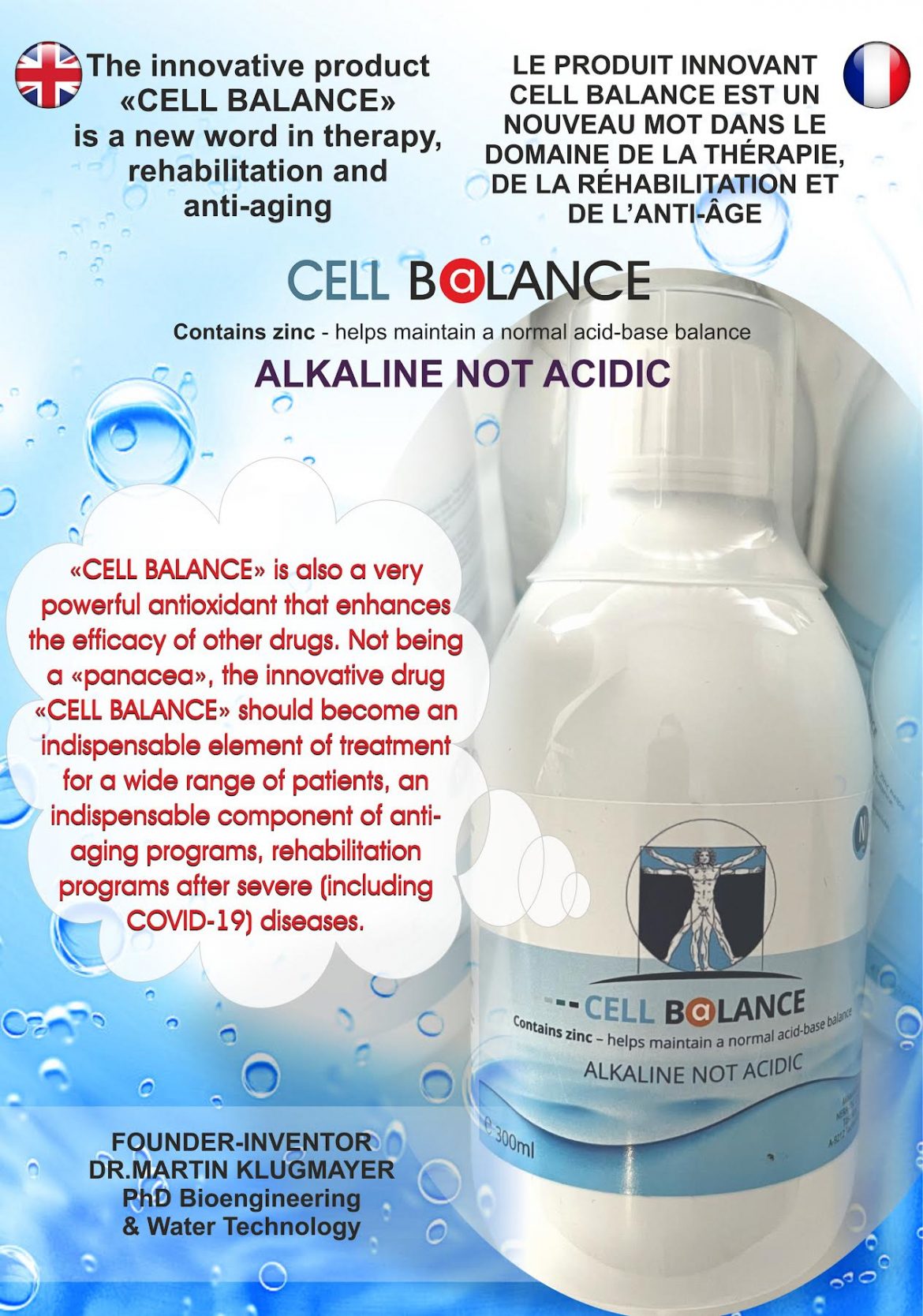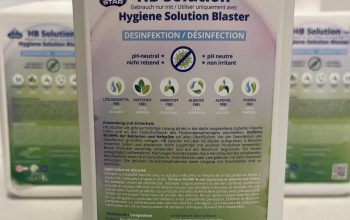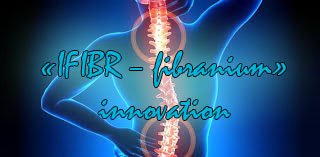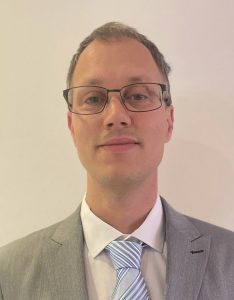
BY Dr MARTIN KLUGMAYER, PhD in Bio Engineering and Water Technology
The article is devoted to the review of a new-generation innovative drug ” CELL BALANCE ” in the light of current scientific views on the role of metabolic disorders – acid-base balance and cellular electricity – in the occurrence of certain diseases, as well as the aging processes of the body.
Keywords: innovative drug, metabolism, acid-base balance, acidosis, free radicals, cell electricity, anti-aging therapy
Over the past few decades the interest in anti-aging medicine has increased dramatically, because with all the disasters, wars and natural cataclysms the life expectancy of the world’s population is growing and the frequency of age-associated diseases is increasing accordingly.
It is known that any pathological condition of the body, any disease or any deviation from normal functioning is inevitably accompanied by disorders of acid-base balance.
Such disorders may develop as alkalosis or as acidosis. Alkalosis is characterized by a shift in the ratio of acids and bases, in which there is an increase in the absolute or relative amount of bases and a decrease in the concentration of hydrogen ions. Acidosis, on the other hand, is a disruption of the acid-base balance, in which blood acidity increases and pH falls below 7.35.
It should be noted that acidosis as such is not a disease, but is a pathological condition, a syndrome that accompanies a number of diseases of the most different groups of therapeutic or surgical profile.
Acidosis may be observed when the processes of anaerobic glycolysis in muscles are intensified. Severe forms of such lactacidosis occur in patients with severe tissue hypoxia, respiratory failure, a decrease in systolic BP below 70 mm Hg. Observed in sepsis, hypovolemia, synthesis of large amounts of D-lactate by intestinal microflora.
In diabetes mellitus, chronic and acute renal failure, alcohol poisoning, methyl alcohol, ethylene glycol, salicylates, liver excretory function disorders ketoacidosis occurs. In addition, the concentration of ketone bodies increases at the terminal stage of shock, with the development of multiple organ failure.
As a result of surgery, during which the ureters are excreted into the intestine in case of bladder failure, as well as in a number of diseases of the gastrointestinal tract, intestinal fistulas – acidosis may be observed as a result of loss of bases.
In medicine, there are several classifications of acidosis – according to pathogenesis, compensation/ decompensation, etc.
It is difficult to overestimate the role of acidosis in the aging process. Currently, there are a number of theories of aging, the theory of oxidative stress occupies a special place among them. Oxidative stress is a decompensation of the organism’s antioxidant system, in which cells are exposed to the damaging effects of free radicals and reactive oxygen species.
Free radicals are unstable atoms and compounds, and they are aggressive oxidizing agents that damage vital body structures. Free radicals occur both under the influence of adverse environmental factors (bad ecology, smoking, chronic intoxication, ultraviolet radiation) and in a number of age-associated diseases: type 2 diabetes and insulin resistance, obesity, arterial hypertension, age-related decrease in sex hormones (in both men and women), vitamin D deficiency.
Oxidative stress can be considered as an inevitable problem for each organism developing through the mechanism of cumulation (accumulation) of free radicals and cumulation of gene mutations in the course of life – the main cause of aging and development of age-related diseases.
The innovative product “CELL BALANCE” is a liquid based on hexagonal water, which includes ions of molecular sodium, hydrogen, oxygen, zinc.
Modern science defines four aggregate states of water: ice, hexagonal (structured) water, liquid, and vapor (steam).
Structured water is a special state of water in which the liquid molecules are arranged in a unique crystal lattice in a special way – where six H2O molecules are in a consecutive connection, forming a ring structure.
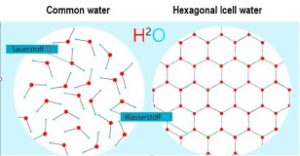
Hexagonal water (also called pi water, structured water) is a unique development that, like many invaluable human inventions, was not created on purpose. In 1964, Nagoya University professor Akihiro Yamashito studied the mechanism of plant blooms. He discovered that if the body’s aqueous environment containing very small amounts of iron salts (Fe2+ and Fe3+) is the most favorable for cellular metabolism. Iron salts contained in pi water are very effective in extremely small amounts and contribute to the formation of small, easily penetrable water clusters in the living cell.
Water content in human organs and tissues is on average: in brain tissue – up to 85%, in the bloodstream – up to 80%, in muscle tissue – 75%. Skin contains up to 64% water, peripheral nervous system – 60%, bone tissue – 30%.
The percentage of water in human organs and tissues changes with age. For example, it is believed that the body of a newborn baby contains up to 80% of water, the body of a middle-aged person – 70%, the body of an elderly person – only 50%.
The main reasons for fluid loss in old age are considered to be changes in the hormonal status of the body, leading to a decrease in the feeling of thirst and the consequent reduction in exogenous intake of water.
An important reason for the decrease in fluid levels in old age is also a decrease in kidney function, leading to a decrease in their concentration functions and the loss due to this more water from the body.
Saturating the body with hexagonal (structured) water increases vitality, slows down the aging process and prevents the development of dangerous diseases caused by dehydration and lack of nutrients in the cells of organs and tissues. As the total amount of water in the human body decreases with age, so does the amount of water that has a hexagonal structure.
A number of studies have established that intracellular structured water surrounds DNA without signs of gene abnormalities, while damaged DNA strands are surrounded by disorganized water.
In order for water to get inside the cell, it must have a very specific structure, i.e. it must be crystalline (structured) to be able to pass through the aquaporins (ion channels of the cell membrane).
An important component of the innovative product “ICELL” is molecular sodium. This element is responsible for regulating fluid balance. It provides the correct distribution of fluid inside and outside the cells of the body. This mineral is predominantly found outside the cells and is present in the body as a positively charged particle. It contributes to the accumulation of electrical voltage on cell membranes and is therefore important for the transmission of nerve impulses, regulation of heart rhythm, and muscle function.
Sodium deficiency is widespread: more than 10% of the elderly suffer – often unknowingly – from sodium deficiency. Typical symptoms of sodium deficiency include impaired concentration, with complaints such as nausea, headaches, muscle cramps (seizures) and low blood pressure added later as the deficiency increases.
Zinc, also included in the formulation of ” CELL BALANCE “, in turn, is the most important element of metabolism, responsible for the metabolism of sugar and proteins – converting them into energy. Zinc plays a key role in cell division.
Zinc contributes to the normal functioning of the immune system, protects cells from oxidative stress and maintains the normal condition of the skin, hair and nails.
Taking ” CELL BALANCE ” can affect the cells in such a way that their ion channels are reopened and only now acids, waste products and toxins can leave the cell. Therefore, deacidification with ” CELL BALANCE ” is the only method that can lead to therapeutic success in the case of
The so-called cellular electricity plays an enormous role in the maintenance of homeostasis, and the vital functions of the organism as a whole. Cellular electricity is a fundamental condition of our life activity. Positive sodium and potassium ions play the main role in cellular electrical activity. They create a potential difference (voltage necessary for electric current) for the elements necessary for the cell to pass through the membrane.
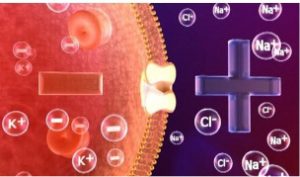
The cells maintain a voltage on their membrane comparable to that of a battery. It was found that healthy cells have a measurable voltage of 70-100 millivolts, with heart cells having the highest voltage (up to 90-100 millivolts).
Constant stress in the modern world, unfavorable environmental conditions accelerating aging processes lead to decrease of cell voltage. People with chronic diseases and alimentary or nervous exhaustion subjectively showed a 30-50 millivolt decrease in cell voltage.
The terminally ill patients exhibited the lowest voltage, less than 15-20 millivolts.
In other words, that reduction of the electrical membrane potential is one of the causes of cell degeneration. Bioelectrical potential is an indicator of normal cell vitality in terms of its oxidative capacity, and failure is a sign of cell failure.
The innovative balanced formulation of ” CELL BALANCE ” allows to normalize the ratio of sodium and potassium ions, providing intracellular transport, the passage of nerve impulses.
The use of “CELL BALANCE ” product allows to influence the organism in complex, to increase working capacity, to decrease the emotional and physical stress, to balance the immune system. The drug can be used for all acute and chronic diseases. This is when ion channels often do not function properly or are even blocked by medications taken specifically to treat a particular disease.
“CELL BALANCE” is also a very powerful antioxidant that enhances the efficacy of other drugs. Not being a “panacea”, the innovative drug ” CELL BALANCE ” should become an indispensable element of treatment for a wide range of patients, an indispensable component of anti-aging programs, rehabilitation programs after severe (including COVID-19) diseases.
